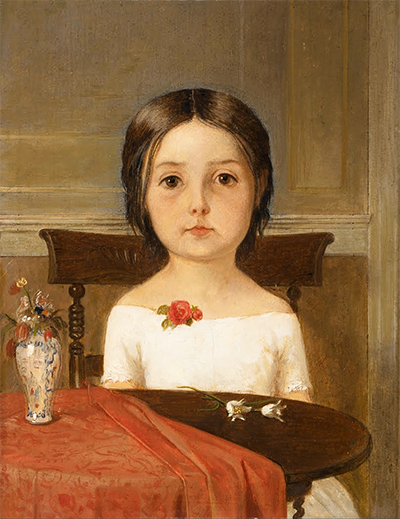Painted in 1846, this painting, the portrait of a child, the eponymous Millie Smith, seems deceptively simple at first glance. The child's head is almost cartoonishly big, her eyes even more so, gazing calmly out of the canvas to meet the viewer's gaze.
Just twenty-five years old when he painted this image, Ford Madox Brown was strongly influenced by the Renaissance painters' move towards great realism in their images, even – perhaps especially – in those images painted to depict myths or biblical scenes. He has ignored the fashion of the time, which was to portray children as endlessly sweet, the epitome of perfect innocence, always to be portrayed as impossibly cherubic.
While young Millie Smith is, indeed, sweetly cherubic, this is probably as a result of her age: children aged between three and five naturally have proportionally larger heads and their eyes are already their full size. This is why young children (and in fact, the young of most mammals) look cute to adults: we are predisposed to feel kindly towards the combination of small bodies and large heads and eyes! However, Madox Brown has eschewed the usual tricks adopted by painters of the very young in those times: impossibly flowing and curling hair that seems about to overwhelm the subject, rosy cheeks that seem to have had rouge used on them, and eyelashes that are so long so as to be highly impracticable!
Instead, Millie is seated formally at a table, with the drape of a folded tablecloth and two seemingly discarded flowers adding some interest to the foreground. She is not smiling, or playing with a doll or puppy as was the custom – instead she is simply gazing out of the picture. It is almost as though her mother has dressed her up nicely, sat her down at the table and said, 'Now look at the nice man, for a moment.' Obedient, the little girl does as she is told, not really understanding what is going on, and, given the slight twist of her mouth, perhaps a little bored!
History does not tell us exactly why Madox Brown painted the child, but it is an established fact that she was the daughter of his landlord in Southend, in accommodations he secured upon his return from Europe, where he had travelled widely, learning and transforming his style of painting. He continued to develop over his long lifetime, and while this painting lacks the professional polish and luminescence of his later works it is full of charm and skill – the watcher almost expects the child to wriggle on her seat, or even slide off the chair and run off to find more exciting matters to attend to! The painting, in oil paint on paper, preserved on a wooden panel, hangs in the Walker Gallery in Liverpool.




